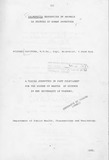Salmonella reservoirs in animals as sources of human infection
Abstract
Salmonellosis is a cosmopolitan zoonotic disease
of considerable importance. In Kenya, salmonellosis
may be more significant in terms of number of
infections and mortality than typhoid fever and
cholera. Animals and animal products have been
regularly incriminated as sources of human infections
for most salmonella serotypes except the anthropophilic
ones. These reservoirs also serve·as sources of
SalQonella infections in domestic aniQals. An
attempt has been Qade to define these reservoirs
through a Survey of domestic animals and rodents
in the Nairobi area. Forty nine salmonella strains
were isolated from a variety of sources, comprising
32 serotypes. The hIghest carrier rate' (7.3~)
was found in wild rodents, m3.inly 3.attus rattus.
The high carrier rate and the tendency of this species
to invade houses indicate that these rodents play
an important role in the epidemiology of salmonellosis,
both in man and animals. The serotype most commonly
recovered in this species was S. enteritidis which
was also the second most prevalent serotype from
human patients at Kenyatta National Hospital during
the period 1974 - 1979. This observation further
supports the, view that wild rodents are of major
importance as sources of infection.
In addition to the standard slide agglutination
method for typing Salmonella strains, the Staphylococcus
coagglutination method according to Kronvall
was used in parallel. Complete agreement was found
between the two methods, but the coagglutination
method was more rapid and far more economical in
terms of reagents than the slide test.
Citation
Master of science,Department of Public Health, Pharmacology and Toxicology,University of Nairobi,1982.Publisher
University of Nairobi Department of Public Health, Pharmacology and Toxicology.

